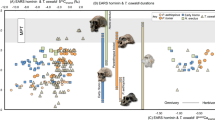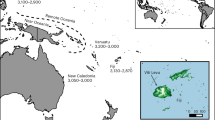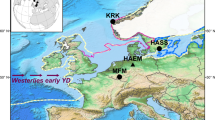Abstract
A substantial extinction of megafauna occurred in Australia between 50 and 45 kyr ago1,2, a period that coincides with human colonization of Australia3. Large shifts in vegetation also occurred around this time, but it is unclear whether the vegetation changes were driven by the human use of fire4—and thus contributed to the extinction event—or were a consequence of the loss of megafaunal grazers5,6. Here we reconstruct past vegetation changes in southeastern Australia using the stable carbon isotopic composition of higher plant wax n-alkanes and levels of biomass burning from the accumulation rates of the biomarker levoglucosan from a well-dated sediment core offshore from the Murray–Darling Basin. We find that from 58 to 44 kyr ago, the abundance of plants with the C4 carbon fixation pathway was generally high—between 60 and 70%. By 43 kyr ago, the abundance of C4 plants dropped to 30% and biomass burning increased. This transient shift lasted for about 3,000 years and came after the period of human arrival and directly followed megafauna extinction at 48.9–43.6 kyr ago1. We conclude that the vegetation shift was not the cause of the megafaunal extinction in this region. Instead, our data are consistent with the hypothesis that vegetation change was the consequence of the extinction of large browsers and led to the build-up of fire-prone vegetation in the Australian landscape.
This is a preview of subscription content, access via your institution
Access options
Subscribe to this journal
Receive 12 print issues and online access
$259.00 per year
only $21.58 per issue
Buy this article
- Purchase on Springer Link
- Instant access to full article PDF
Prices may be subject to local taxes which are calculated during checkout



Similar content being viewed by others
Change history
16 July 2013
In the version of this Letter originally published online, the published online date was incorrect; it should have read 1 July 2013. This has been corrected in all versions of the Letter.
References
Roberts, R. G. et al. New ages for the last Australian megafauna: Continent-wide extinction about 46,000 years ago. Science 292, 1888–1892 (2001).
Grün, R. et al. ESR and U-series analyses of faunal material from Cuddie Springs, NSW, Australia: Implications for the timing of the extinction of the Australian megafauna. Quart. Sci. Rev. 29, 596–610 (2010).
Bowler, J. M. et al. New ages for human occupation and climatic change at Lake Mungo, Australia. Nature 421, 837–840 (2003).
Turney, C. S. M. et al. Late-surviving megafauna in Tasmania, Australia, implicate human involvement in their extinction. Proc. Natl Acad. Sci. USA 105, 12150–12153 (2008).
Rule, S. et al. The aftermath of megafaunal extinction: Ecosystem transformation in Pleistocene Australia. Science 335, 1483–1486 (2012).
Flannery, T. F. Pleistocene faunal loss: Implications of the aftershock for Australia’s past and future. Archaeol. Oceania 25, 45–67 (1990).
Wroe, S. & Field, J. A review of the evidence for a human role in the extinction of Australian megafauna and an alternative interpretation. Quat. Sci. Rev. 25, 2692–2703 (2006).
Miller, G. H. et al. Pleistocene extinction of Genyornis newtoni: Human impact on Australian megafauna. Science 283, 205–208 (1999).
Miller, G. H. et al. Ecosystem collapse in Pleistocene Australia and a human role in megafaunal extinction. Science 309, 287–290 (2005).
Jones, R. Fire-stick farming. Austr. Nat. Hist. 16, 224–228 (1969).
Harle, K. J. Late Quaternary vegetation and climate change in southeastern Australia: Palynological evidence from marine core E55-6. Palaeogeogr. Palaeoclim. Palaeoecol. 131, 465–483 (1997).
Singh, G. & Geissler, E. A. Late Cainozoic history of vegetation, fire, lake levels and climate, at Lake George, New South Wales, Australia. Phil. Trans. R. Soc. Lond. B 311, 379–447 (1985).
Johnson, B. J. et al. 65,000 years of vegetation change in central Australia and the Australian summer monsoon. Science 284, 1150–1152 (1999).
Eglinton, G. & Hamilton, R. J. Leaf epicuticular waxes. Science 156, 1322–1335 (1967).
Simoneit, B. R. T. Biomass burning—A review of organic tracers for smoke from incomplete combustion. Appl. Geochem. 17, 129–162 (2002).
Hill, P. J. & De Deckker, P. AUSCAN seafloor mapping and geological sampling survey on the Australian southern margin by RV Marion Dufresne in 2003: Final project report. Geosci. Austr. Rec. 2004/4, 1–144 (2004).
Lopes dos Santos, R. A., Wilkins, D., De Deckker, P. & Schouten, S. Late Quaternary productivity changes from offshore Southeastern Australia: A biomarker approach. Palaeogeogr. Palaeoclim. Palaeoecol. 363–364, 48–56 (2012).
Gingele, F., De Deckker, P. & Norman, M. Late Pleistocene and Holocene climate of SE Australia reconstructed from dust and river loads deposited offshore the River Murray Mouth. Earth Planet. Sci. Lett. 255, 257–272 (2007).
Castañeda, I. S. et al. Wet phases in the Sahara/Sahel region and human migration patterns in North Africa. Proc. Natl Acad. Sci. USA 106, 20159–20163 (2009).
Diefendorf, A. F., Freeman, K. H., Wing, S. L. & Graham, H. V. Production of n-alkyl lipids in living plants and implications for the geologic past. Geochim. Cosmochim. Acta 75, 7472–7485 (2011).
Hattersley, P. W. The distribution of C3 and C4-Grasses in Australia in relation to climate. Oecologia 57, 113–128 (1983).
Still, C. J., Berry, J. A., Collatz, G. J. & DeFries, R. S. Global distribution of C3 and C4 vegetation: Carbon cycle implications. Glob. Biogeochem. Cycles 17, 1022 (2003).
Hopmans, E. C. et al. A novel proxy for terrestrial organic matter in sediments based on branched and isoprenoid tetraether lipids. Earth Planet. Sci. Lett. 224, 107–116 (2004).
Nanson, G.C., Callen, R. A. & Price, D. W. Hydroclimatic interpretation of Quaternary shorelines on south Australian playas. Palaeogeogr. Palaeoclim. Palaeoecol. 144, 281–305 (1998).
Magee, J. W., Miller, G. H., Spooner, N. A. & Questiaux, D. Continuous 150 ky monsoon record from Lake Eyre, Australia: Insolation-forcing implications and unexpected Holocene failure. Geology 32, 885–888 (2004).
Bowler, J. M. et al. in Peopled Landscapes Vol. 34 (eds Haberle, S. & David, B.) 271–296 (Terra Australis, 2012).
Gingele, F. & De Deckker, P. Late Quaternary fluctuations of palaeoproductivity in the Murray Canyons area, South Australian continental margin. Palaeogeogr. Palaeoclim. Palaeoecol. 220, 361–373 (2005).
Reimer, P. J. et al. Intcal09 and Marine09 radiocarbon age calibration curves, 0-50,000 Years Cal BP. Radiocarbon 51, 1111–1150 (2009).
Schouten, S., Huguet, C., Hopmans, E.C., Kienhuis, M.V.M. & Sinninghe Damsté, J.S. Analytical methodology for TEX86 paleothermometry by high-performance liquid chromatography/atmospheric pressure chemical ionization-mass spectrometry. Anal. Chem. 79, 2940–2944 (2007).
Hopmans, E. C., Lopes dos Santos, R. A., Mets, A., Sinninghe Damsté, J.S. & Schouten, S. A novel method for the rapid analysis of levoglucosan in soils and sediments. Org. Geochem. 58, 86–88 (2013).
Acknowledgements
We thank J-B. Stuut for assistance in the field and J. Ossebaar, M. Kienhuis, M. Baas, M. Verweij and W. I. C. Rijpstra for analytical assistance. Research funding was provided by a VICI grant to S.S. from the Netherlands Organization of Scientific Research. Core MD03-2607 was obtained with a National Oceans Office and Australian Research Council Discovery grant, both awarded to P.D.D. Y. Balut from IPEV was instrumental in obtaining the core. Several of the 14C dates were obtained via an AINSE grant (07036) awarded to P.D.D. S. Fallon provided the two additional radiocarbon analyses listed in the Supplementary Section.
Author information
Authors and Affiliations
Contributions
S.S. and P.D.D. designed the study. R.A.L.d.S. performed the analysis with input from E.C.H. and A.M. All authors participated in the data analysis and interpretation of the results. R.A.L.d.S. and S.S. wrote the manuscript with contributions from all authors.
Corresponding author
Ethics declarations
Competing interests
The authors declare no competing financial interests.
Supplementary information
Supplementary Information
Supplementary Information (PDF 660 kb)
Rights and permissions
About this article
Cite this article
Lopes dos Santos, R., De Deckker, P., Hopmans, E. et al. Abrupt vegetation change after the Late Quaternary megafaunal extinction in southeastern Australia. Nature Geosci 6, 627–631 (2013). https://doi.org/10.1038/ngeo1856
Received:
Accepted:
Published:
Issue Date:
DOI: https://doi.org/10.1038/ngeo1856
This article is cited by
-
Seasonal origin of the thermal maxima at the Holocene and the last interglacial
Nature (2021)
-
Anhydrosugars as tracers in the Earth system
Biogeochemistry (2019)
-
On modelling the relationship between vegetation greenness and water balance and land use change
Scientific Reports (2018)
-
Extensive wet episodes in Late Glacial Australia resulting from high-latitude forcings
Scientific Reports (2017)
-
Local and regional wildfire activity in central Maine (USA) during the past 900 years
Journal of Paleolimnology (2017)



